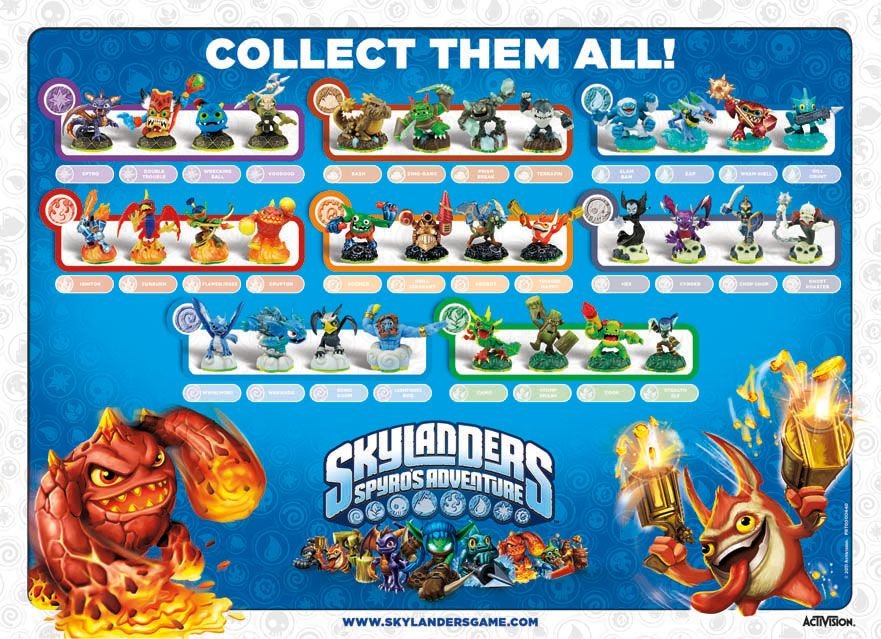Chronicling the fall of the Skylanders franchise
By Arman Manternach ‘23
Image courtesy of Gamespot
Skylanders Figurines Meet Their Demise
About a month ago, I saw a stirring headline: “Attention all Skylanders Owners: The Chips at the Bottom of the Skylanders are Dying, and Within a Few Years, They Will all be Dead.”
Was this true? It didn’t matter. My early-morning caffeine-fueled rummaging in the attic was fruitful, and I emerged about 45 minutes later clutching two boxes of first-generation Skylanders, high-quality figurines that can be sent into battle. Ready to relive my childhood memories, I even dusted off my first-gen portal of power that connects to consoles via a USB receiver to send Skylanders placed on the portal into the game.
With the initial wave of panic behind me, it was time to learn more about the impending mass extinction event. As it turns out, Skylanders are not dying en masse, but some gamers have pushed the RFID chips embedded in the base of each Skylander to the end of their natural lifespan.
Like an RFID key fob that unlocks the main entrance of an apartment building, Skylanders’ RFID tags transmit information when radiation from the RFID reader, the portal of power, turns the RFID tag on, and the tags die after about 10,000 uses. Additionally, the batteries that power the RFID tags reach their expiry after about 10 years, so a combination of heavy use and time seems to be a death sentence for Skylanders figures.
More on how RFID tags work; see “Semi-Active Tags”
Clockwise from upper left: RFID Key Fobs, courtesy of Greenwich Locksmiths; Tree Rex, a Sklyander Giant, courtesy of Alamy; The base and RFID tag of a Skylander, courtesy of SkylandersCharacterList.
The Skylanders Franchise Meets an Underwhelming End
TL;DR: Activision pressured its developers to release games yearly so they could sell new Skylanders with some minor differences at a higher price. Consumers did not want to buy into toys-to-life every single year, and a year is generally not enough time to develop an interesting game.
Nowadays, the imminent demise of many early-gen Skylanders is only relevant to niche gaming communities and nostalgia seekers like me, but 10 years ago, Skylanders was a household name. What happened? Skylanders: Spyro’s Adventure, the first entry in the Skylanders series, was released just in time for the holiday season in 2011, and according to critics, it was a runaway success.
The toys-to-life concept was brand new, and being able to collect high-quality figurines that doubled as playable characters was cutting-edge and exciting for players. The game itself had plenty of humor aimed at both kids and adults, and combat was simple and satisfying, with virtually every attack being spammable against the computer-controlled armies of darkness. Even the story was interesting, featuring a comically expressive pint-sized villain, Kaos, and the game featured an epic soundtrack composed by Hans Zimmer (Pirates of the Caribbean, The Lion King, Gladiator). By March 31, 2012, Activision had sold more than 30 million Skylanders.
The beginning of the end for Skylanders was the announcement of the first sequel, Skylanders: Giants. Even though this game delivered as well as its predecessor in every regard, reduced sales proved that many consumers were unwilling to buy into a new toys-to-life experience when they had invested in the original game from only a year earlier.
Skylanders would go on to release a new game every year until 2016, introducing a new gimmick annually that allowed them to sell more Skylanders. The first gimmick was the Giants, triple-sized figurines that went for around $20 a piece, followed by the Swap Force, Skylanders that had mix-and-matchable top and bottom halves, that also ran around $20, and later years introduced villain traps, Skylander cars (superchargers), and custom Skylanders. Every year posted fewer sales than the preceding one.
Toys-to-life is an expensive genre to play, and people were not willing to reinvest in a new game every single year. This was worsened by other brands gnawing at Skylanders’ market share. Most notable was Disney Infinity, a knockoff of Skylanders with Disney and Pixar characters, which hit shelves in 2013. Activision, the publisher of Skylanders, had rushed the development of the games to squeeze as much cash out of them as possible before the franchise died after the final game’s release in 2016. They phased out the game’s original development team, Toys for Bob, between the third and fourth games in favor of Vicarious Visions, a studio that could churn out the yearly games that Activision demanded.
The yearly releases not only devalued the Skylanders from the previous year, it led to the release of short, rushed storylines that killed the magic built by the original game which had been in development for much longer.
The crumbling of the Skylanders brand and the death of the beloved figurines have pushed Skylanders towards irrelevance. The fall of this franchise marks the end of toys-to-life gaming, which rivals the Battle Royale concept as the most notable gaming craze to come from the 2010s. But there are murmurings. Trouble is brewing in Skylands. Will a Portalmaster rise to vanquish darkness one last time in 2023?


